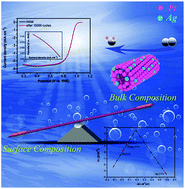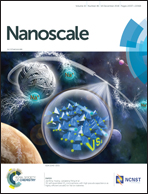Porous platinum–silver bimetallic alloys: surface composition and strain tunability toward enhanced electrocatalysis†
Abstract
Promoting surface strains in heterogeneous catalysts and heteroatomic interactions in alloying offer an effective strategy for the development of electrocatalysts with greatly enhanced activity. In this work, we design platinum–silver nanotubes (PtAg NTs) with tunable surface compositions by a controlled galvanic replacement reaction of well-defined Ag nanowires (NWs). The optimized and porous PtAg NTs (PtAg-4 NTs), with the Pt5Ag3 surface composition and (111) facet-dominant surface features, exhibit an extraordinary oxygen reduction reaction (ORR) activity that reaches a specific activity of 1.13 mA cm−2 and a mass activity of 0.688 A mg−1Pt at 0.9 V versus a reversible hydrogen electrode (RHE), which are 4.5 times and 4.3 times those of commercial Pt/C catalysts (0.25 mA cm−2 and 0.16 A mg−1Pt). Moreover, PtAg-4 NTs/C can endure under the ORR conditions over the course of 10 000 cycles with negligible activity decay. Remarkably, density functional theory simulations reveal that the porous PtAg-4 NTs exhibit enhanced adsorption interaction with adsorbates, attributed to the catalytically active sites on high-density (111) facets and modulation of the surface strain, further boosting the ORR activity and durability.



 Please wait while we load your content...
Please wait while we load your content...